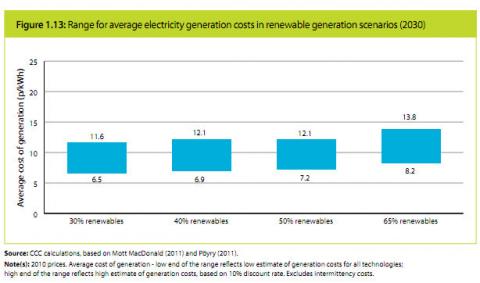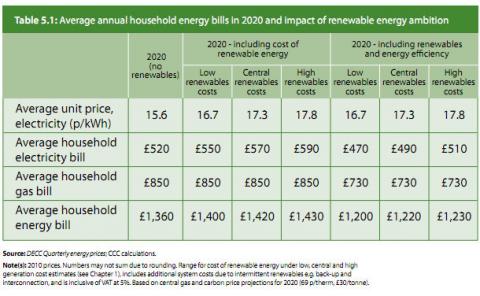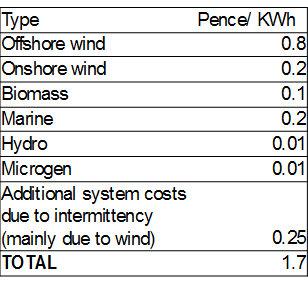Are wind turbines to blame for projected rises in electricity bills?
"ELECTRICITY bills could rise by another £50 a year to help build a new forest of wind turbines, a report warned yesterday. It predicted that Britain will need nearly 15,000 giant turbines and said that supporting renewables is expected to lead to a 10 per cent rise in electricity bills by 2020." The Express, 9 May 2011.
"It says nuclear power, which produces no carbon dioxide, should play a central role in meeting its recommended target of cutting emissions by 60 per cent by 2030. The cost of meeting the target is expected to add at least £50 to the average household's annual energy bills in the next ten years." The Times, 9 May 2011.
Both the Express and the Times today reported on the projection by the Committee on Climate Change that electricity bills are likely to rise by £50 for the average family over the next decade. While the Times focused on nuclear power, according to the Express wind power was to blame for the increased likely costs.
Seeking clarification, Full Fact took a closer look at the report.
The new figures come from the Committee on Climate Change Renewable Energy Review, looking at the potential for renewable energy development in the UK.
Considering the likely cost of the different renewables options over the coming decades, it concludes: "We estimate that the cost of supporting renewable electricity to 2020 will add up to 2 p/kWh to the electricity price, increasing the average annual household electricity bill by around £50-60 in real terms.
-
Around half of this cost is due to supporting offshore wind.
-
There is also some cost from onshore wind, though by 2020 new projects are likely to be competitive without specific support.
-
This represents around a 10% increase on what household electricity bills would otherwise be in 2020."
The Express have rightly highlighted a projected real terms increase in electricity bills of around 10 per cent by 2010, with wind power making up a majority of this cost.
However, while wind power did make up over 50 per cent of this figure, it by no means accounts for the entire rise, as implied by the Express.
We got in touch with the Committee on Climate Change to find out more about the energy sources that constitute the remainder of this figure, and will update this article with any more information they give us.
The Committee on Climate Change review further draws attention to the overall uncertainty in these figures.
It stated that: "There is a high degree of uncertainty over scenario costs and investment requirements, given underlying uncertainty around the costs of specific technologies... Our analysis suggests that generation mixes with high renewables shares would be very expensive if technology costs do not reduce towards the optimistic ends of the ranges for future estimates. However, it is also plausible for generation mixes with high renewable shares to be lower cost than mixes with low renewable shares if renewable costs come down rapidly, whilst nuclear and Carbon Capture and Storage costs do not."
The projections below cover the different scenarios, demonstrating the very different cost implications of renewables in the UK, dependent upon what cost reductions they achieve in the coming years.


The report also notes that a government base on the carbon price of £30/ tonne by 2020 would add £20 to the average household electricity bill, while projected increases in gas prices in 2020 are likely to add further costs; both of these are independent of the renewables figure.
Conclusion
Reading the Express' article on the expected £50 rise in average electricity bills by 2020, the reader could be forgiven for thinking that wind power was entirely to blame.
Indeed, in this case by opting for the more provocative headline, the report misses out on credibly relaying the report's findings.
A closer read of the Committee for Climate Change's report shows that while wind power does make up over 50 per cent of the expected rise, it is not the only energy type contributing to this figure. Further, the report strongly distinguishes between onshore wind, which it says should have a similar cost to nuclear by 2020, and offshore wind, which is argues needs to achieve big cost reductions in the coming years.
The report also highlights the big uncertainties involved in all of these figures, publishing detailed projections of different scenarios over the coming decades.
UPDATE
The Committe on Climate Change has now replied to Full Fact with a more detailed breakdown of the projected cost of renewables by 2020.
They said: "We estimate that the cost of supporting renewable electricity will add 1.7p to the electricity price in 2020 in a central case. Based on average annual consumption of 3,300 kWh per year, this would add approximately £50-60 to the average household bill. The basis for this calculation is the share of renewable generation rises to around 30% in 2020, with offshore wind making up the majority of renewable generation."
The projection of a cost of 1.7p to electricity can be broken down into the following componants.
